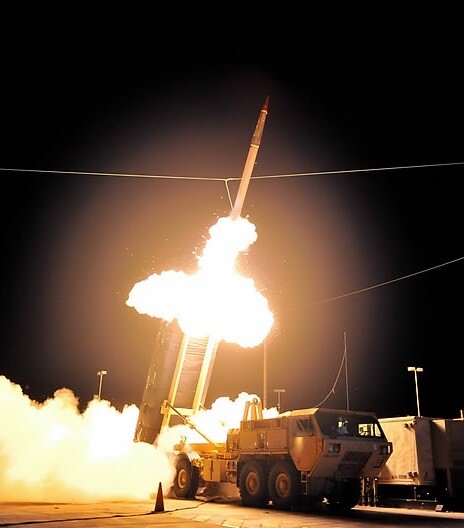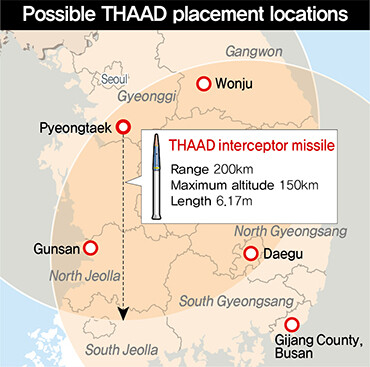hankyoreh
Links to other country sites 다른 나라 사이트 링크
Defense Ministry will “not consider the positions of other countries” in THAAD decision

The Ministry of National Defense announced plans to form a joint working group (JWG) with the US as early as next week to discuss the deployment of a Terminal High Altitude Area Defense (THAAD) system with United States Forces Korea (USFK).
The JWG’s establishment will mean the beginning of full-scale discussions on the timeline and site for deployment. Attention is now focusing on the ministry’s reasons for saying it would “not consider the positions of other countries” - including China - on the controversial issue of site selection.
“South Korea and the US are currently at the final agreement stage in the signing of an agreement to serve as a standard for joint working group management,” a senior Ministry of National Defense source said on Feb. 12.
“We expect the JWG will be able to start discussing issues related to THAAD deployment as early as next week,” the source added.
The predictions suggest the agreement currently under discussion will be signed early next week, with the JWG beginning official discussions simultaneously with the signing.

Representatives for the JWG will reportedly be Ministry of National Defense policy planning officer and Army Maj. Gen. Jang Kyung-soo on the South Korean side and USFK Assistant Chief of Staff for Strategy and Marines Maj. Gen. Robert Hedelund for the US.
“The JWG will be talking about the discussion schedule, the timeline for THAAD deployment, and suitable sites,” the source said.
“They’ll discuss issues such as safety and environmental costs according to South Korean and US domestic law and SOFA [the Status of Forces Agreement],” the source added.
On the site issue, the same source said the selection would focus on “a place that maximizes THAAD’s military effectiveness without impacting resident safety or the environment.”
“Some news outlets have written that we’ll be taking China into account when deciding what region to deploy [THAAD] to, but it is not the military’s approach to consider the positions of other countries when choosing a region for THAAD deployment,” the source said.
The statement from the ministry could be read literally as maintaining that the final determination will be based mostly on “military effectiveness” rather than diplomatic ties with other countries that are currently reacting sensitively to the THAAD issue - most notably China and Russia. But it could also be seen as suggesting the system may end up deployed in a West (Yellow) Sea coast city such as Pyeongtaek or Gunsan instead of the Daegu/North Gyeongsang region, which has been mentioned as a candidate site by the press.
Pyeongtaek, Gunsan, and Daegu are among five to six locations mentioned as possible THAAD deployment sites, along with Waegwan and Wonju. Recently, some news outlets cited administration sources as saying that South Korea and the US were considering the North Gyeongsang region rather than the West Sea coast or central region out of concerns about possible objections from Beijing.
Indeed, China has been very sensitive about the THAAD deployment issue, with foreign ministry spokesperson Hua Chunying stressing on Feb. 7 that “countries must take the security of other countries and regional peace into account when attempting to ensure their own security.” For this reason, the South Korean Ministry of National Defense’s stated plans to “not consider the positions of other countries” could end up a source of frictions between Seoul and Beijing.
In response to concerns about the resident and environmental impact of THAAD’s AN/TPY-2 radar, the ministry cited US safety standards based on a 2015 environmental impact assessment report for a THAAD system based in Guam. In it, the radar is specified as not being harmful to people outside a 100-meter radius as long as its angle is kept at five degrees from the earth’s surface.
“We will be applying [those specifications] to South Korea’s topographic conditions,” the ministry said.
The ministry also stated on Feb. 12 that only one THAAD battery would be assigned to USFK, adding that the deployment would not result in any increase in South Korea’s financial defense contribution.
By Kim Ji-eun, staff reporter
Please direct questions or comments to [english@hani.co.kr]

Editorial・opinion
![[Column] Park Geun-hye déjà vu in Yoon Suk-yeol [Column] Park Geun-hye déjà vu in Yoon Suk-yeol](https://flexible.img.hani.co.kr/flexible/normal/500/300/imgdb/original/2024/0424/651713945113788.jpg) [Column] Park Geun-hye déjà vu in Yoon Suk-yeol
[Column] Park Geun-hye déjà vu in Yoon Suk-yeol![[Editorial] New weight of N. Korea’s nuclear threats makes dialogue all the more urgent [Editorial] New weight of N. Korea’s nuclear threats makes dialogue all the more urgent](https://flexible.img.hani.co.kr/flexible/normal/500/300/imgdb/original/2024/0424/7317139454662664.jpg) [Editorial] New weight of N. Korea’s nuclear threats makes dialogue all the more urgent
[Editorial] New weight of N. Korea’s nuclear threats makes dialogue all the more urgent- [Guest essay] The real reason Korea’s new right wants to dub Rhee a founding father
- [Column] ‘Choson’: Is it time we start referring to N. Korea in its own terms?
- [Editorial] Japan’s rewriting of history with Korea has gone too far
- [Column] The president’s questionable capacity for dialogue
- [Column] Are chaebol firms just pizza pies for families to divvy up as they please?
- [Column] Has Korea, too, crossed the Rubicon on China?
- [Correspondent’s column] In Japan’s alliance with US, echoes of its past alliances with UK
- [Editorial] Does Yoon think the Korean public is wrong?
Most viewed articles
- 1‘We must say no’: Seoul defense chief on Korean, USFK involvement in hypothetical Taiwan crisis
- 2N. Korean delegation’s trip to Iran shows how Pyongyang is leveraging ties with Moscow
- 346% of cases of violence against women in Korea perpetrated by intimate partner, study finds
- 4[Column] Park Geun-hye déjà vu in Yoon Suk-yeol
- 5‘Weddingflation’ breaks the bank for Korean couples-to-be
- 6Will NewJeans end up collateral damage in internal feud at K-pop juggernaut Hybe?
- 7Amnesty notes ‘erosion’ of freedom of expression in Korea in annual human rights report
- 8[Interview] Dear Korean men, It’s OK to admit you’re not always strong
- 9Korean government’s compromise plan for medical reform swiftly rejected by doctors
- 10[Editorial] Japan’s rewriting of history with Korea has gone too far